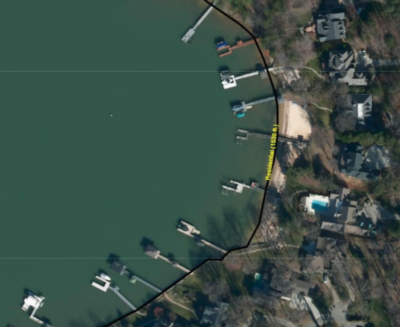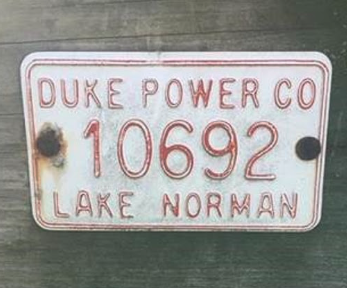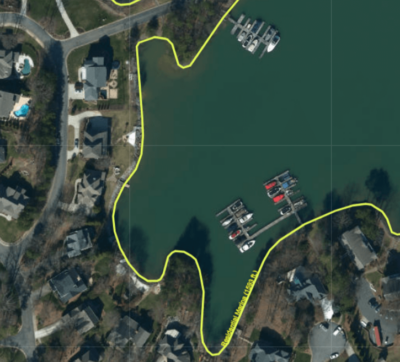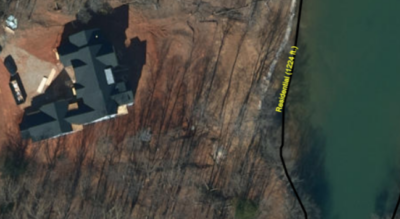This is part of a series of articles…
…”diving” into the waterfront Lake home topics of Docks, Water, Shore + Buffers, Lifestyle, and Process.
Each article will empower you to feel confident in a waterfront home purchase.
IMAGINE THIS: You buy a waterfront home on a quiet cove, thinking you can build a dock, install a swimming pool, and cut down a few trees to clear the view.
If you’re working with a real estate broker who doesn’t understand waterfront Lake Norman homes, they might miss some important things:
#1 It’s next to an “environmental” shoreline classification, plus the lot is only 50-ft of waterfront; therefore a dock cannot be built since it would violate the environmental buffer.
#2 The rear lot is only 30-ft deep, and therefore a pool cannot be built in the buffer zone between the “760” shoreline mark and the home.
#3 The large trees are in a “Critical Area” watershed and cannot be removed as they are needed to absorb toxins from the runoff areas of the home.
If you’re living on Lake Norman waterfront property, odds are you’ll want to have an amazing dock to entertain and enjoy all year long.
Let’s cover some basics…
Duke Energy is the Boss
They built the dam that created Lake Norman, they manage the water & shoreline, and they maintain the natural ecology of those areas.
This means that ALL docks, piers, boat slips and other shoreline structures (seawalls, beaches, plants, stairs, etc)require their permission to build, repair or make changes of any kind.
Other Regulations
It’s important to note, many State and Local laws also apply, and if the homes community has an HOA (Homeowners Association), their CCR’s (Covenants, Conditions, and Restrictions) will apply and may prohibit things discussed in this article.
Types of Docks
Docks have 3 separate types / uses:
Pier
These are fixed structures extending over the water with no place to tie up and dock a boat, nor a boat slip. Mainly used to sit on and enjoy a cool beverage.
Dock
Has a place to park / tie up a boat. Can be floating (rises and falls with lake level over the seasons) or fixed (permanent height attached to pilings). You will need a boat lift for fixed docks but they are more durable in open water areas.
Slip
At the end of a dock, enclosed on 3 sides like a parking spot for your boat.
Dock Scenarios
When looking at waterfront Lake Norman homes, you’ll come across these dock scenarios:
- Private Docks
- Shared Docks
- Dock “Not Allowed”
- Dock “Doesn’t Exist”
1. Private Docks
This is the most common and sought after dock setup for waterfront Lake Norman homes.
If you don’t mind the maintenance, this is the premium advantage of living on Lake Norman waterfront property.
Shoreline Classifications
Every inch of Lake Norman shoreline is classified with 1 of 17 classifications, which tells a buyer what can be built on and around the shoreline.
Here is a satellite view showing the docks for a waterfront community in Cornelius.

Notice theblack linerunning along the shore. This means it is classified as “Residential” (aka “can have a private dock”).
All good so far, we found a home that already has a private dock and is classified “Residential”.
Rules for Size, Cover, and Features
If the current dock doesn’t meet your amazing vision for fun and you want to add slips, a covered gazebo, make it longer, etc…then you’ll need the following info (remember, any change needs Duke Energy’s permission).
Size & Coverage
The basic answer is a dock (and its features) can cover 1,000 sq/ft of water*.
That includes the total of:
- Floating & Fixed docks (the part you walk on)
- Steps into the water (from dock OR shore)
- Covered areas (roofs, roof decks, gazebos)
- Boat slips per dock = 2 max
- PWC (jetski) floating mooring devices = 2 max
*Note there are other limitations based on the date the lot was created and the length of shoreline. See here:
- New lots with less than 100-ft of shoreline cannot have docks.
- Lots created before Sept 1, 2006, with more than 75-ft of shoreline can have 10 sq/ft dock for every foot.
- Lots created before June 1, 1996, with less than 75-ft of shoreline can have 10 sq/ft dock for every foot.
Features
So what awesome things can you have on your docks? Let’s look at the feature limitations:
Allowed:
- Enclosed Storage Closet – 1 for covered docks on one of the corners of the structure closest to shore.
- Boat lifts and PWC floats – they can be on pilings attached to the dock or inside the boat slip.
- Swim Platforms – If attached to the dock and it doesn’t exceed the 1,000 sq/ft limit.
Not allowed:
- Enclosed sides of a dock gazebo or roof (except for handrails)
- Sinks, toilets, showers, spigots or any other type of device, which could cause any liquid or solid waste to be discharged into the lake.
Imagine these scenarios…
#1
The home’s dock is 1,000 sq/ft already. It doesn’t have any covered areas but you’d like to add one to cover the boat slip so you wouldn’t have to cover the boat during rain and periods of non-use.
This would not be allowed since the roof would cover the water area where the boat is parked (previously uncovered), putting you over the allowed limit.
#2
The dock is 990 sq/ft. You want to add 2 jet ski floating pads on the side. This would not be allowed if the 2 pads are over 10 sq/ft. You might only be able to add 1 pad.
#3
Your dock is 1,000 sq/ft, it has a great cover and jet ski pads already. You want to build some stairs from your shoreline to the water. This is not allowed as stairs from the dock OR shoreline count towards the max sq/ft, since they cover the water.
#4
You want to add a few extra mooring pilings next to your dock. This is OK, and doesn’t count towards any sq/ft. You don’t even need a permit, but you need to notify Duke of your intent to do it.
#5
Roof/sun decks on your dock? Yes! – Decks, gazebos, covered boat slips, and boat shelters must be single-story structures, BUT they may be roofed and designed to allow second story use (e.g., sundeck); however, the second story must not be roofed creating a two-story roofed structure.
Dredging (excavating)
Sometimes you’ll see an amazing waterfront property and notice the water looks very shallow around the dock.
Dredging can be done to provide boat access ONLY. Permits are not issued for swimming, beach or any other leisure activities.
You may dredge in the following areas:
- A 10 foot area under and around your dock:
- A turnaround area in front of your slip
- A path to deep water
Dredging requires a lot of approvals and is very costly. We will always refer you to a professional. You cannot dredge March – June during spawning season.
Is the dock permitted?
So the dock is there, how do you know everything is to code and done properly?
At minimum when viewing a property you will know if the dock was permitted because it will have a “Duke Power Co” Permit Plate attached to the end of it (like this one).

Note: just because the dock has a permit plate, does not mean all the work done to the dock over its life was permitted. Remember, every fix no matter how small (a few boards) needs Duke Energy’s approval.
Permit Process
We will walk you through the full process if under contract to purchase a waterfront Lake Norman home, but it goes like this:
#1– Request the seller to provide a copy of the pier permit and application.
- Seller has records? – If the existing permit plate above matches what was permitted, the dock was permitted and should be compliant.
- Seller doesn’t have records? – Ask the seller to request a copy from Duke Energy Lake Services atno charge. Lake Services will only provide records that are in the seller’s name. If the seller never transferred the structure, they must submit an application to transfer the permit into their name in order to access the record. The transfer process will identify any compliance issues.
#2– If the seller can’t provide any permitting history…
…or the existing structure differs from what was originally permitted, there may be a lake use permitting compliance issue.
#3– If you do buy the home, you will need to transfer the dock into your name.
Submit a Lake Permit application & User’s Agreement, available on the Duke Energy website. Lake Services will inspect the dock to ensure it was properly permitted and has not been modified without approval.
If any noncompliance issues are found, you as the current owner will likely be responsible for correcting the issues.
What else do I need to know?
Small Coves
Looking at coves less than 25 ft wide? No new or expanded docks will be authorized in these areas.
Other People Fishing around my Dock & Shoreline
Lake Norman is available for public recreation including boating, swimming, fishing and wading. While Duke Energy’s lake use permits allow permittees to restrict access to docks, those permits do not allow the lake neighbor to restrict public use of the lake or the shoreline.
Oversized Docks & Boathouses
Have you seen docks that look oversized, have enclosed boat houses on them, have 3 slips, or have 2 docks for one house?
- These are built before the current rules and are grandfathered in (they are “non conforming”).
- So you scored right, buying a home with a dock that looks like a floating game room?Yes & No… when you go to change, modify or add something, you will need a permit. New permits need to comply with current regulations. A small modification (adding a floating boat pad), might require a total reconfiguration of your dock to meet current regulations.
Ok, so you get it now, you need a permit to do everything. All changes require a Lake Permit Application and Users Agreement and if you’re curious you can see it here: lAKE permit
2. Shared Docks
This is common in many waterfront homes of Lake Norman. The home will have access to a nearby community dock area, which contains boat slips for each house.
This is ideal if you don’t want to deal with the upkeep and maintenance on your own, but still prefer to have boat access nearby.
This is referencing mainly small community shared docks, not Marina shared docks. Each have different rules.
Shoreline Classification
Here is a satellite view showing the shared docks for a waterfront Lake Norman community.

Notice the Yellow line around the shoreline, this means it is zoned as a “Residential Marina” (aka Shared Docks).
Notice the homes on the left, if you were house hunting and thinking of adding a dock in the future, you’d be wrong. It would not be permitted.
Community CCRs
The CCRs (covenants, conditions, and restrictions) for a specific community will contain how the dock is maintained, and if there are any usage restrictions in addition to the guidance from Duke Energy, so we cannot go into any lengthy detail on this.
You can install a PWC float for a jet ski, but it must be installed within the confines of a slip AND the addition of the PWC float does not increase the total number of watercraft that the facility is designed to accommodate. So if you get one slip, you can only park one jet ski (no other boats).
3. Dock “Not Allowed”
Whether a dock is allowed depends again on the classification of the shoreline.
Typically in smaller coves or areas of ecological sensitivity, you might have a beautiful waterfront Lake Norman home, but a dock will not be allowed.
Shoreline Classification
When a shoreline is zoned as “Environmental” it means No Docks Allowed.
There are waterfront Lake Norman homes that will not be allowed to have private docks. The only way docks will be able to be built is if it starts 50ft from the end of the environmental area.
Sometimes, homes in these areas have shared docks nearby in more open water areas.
4. Dock “Doesn’t Exist”
Though rare, you may come across a waterfront home for sale on Lake Norman with no dock yet. There are a few basic things you need to look at:
Shoreline Classification
Be sure to verify the classification of the shoreline to make sure it is either “Residential” or “Future Residential” to see if a dock is allowed. Notice this home (likely a new construction), does not yet have a dock (but it is allowed).

Be sure to know the measurement of the shoreline, it must be 100-ft long to allow for a dock with todays regulations.
Violations – What’s the Worst that can Happen?
Now that you have a good basic knowledge (we hope) of docks, what happens if you violate those rules?
Refusal to remove an unapproved, dilapidated, or unsafe structure can result in:
- Removal of the structure from the waterfront home by DE-LS (Duke Energy Lake Services)
- Loss of consideration for lake use permitting activities until cost of removal, which includes all removal costs including DE-LS or contractor expenses, landfill fees, and a set management fee of $1,000, is paid.
Unauthorized structure built within the Project Boundaries:
- After-the-fact application may be accepted if structure conforms to the specific requirements, but the fee will be twice the current permit fee to cover additional management costs.
- Non-complying structures will be subject to modification or removal and restoration of disturbed areas at the owner’s expense.
A final note from DE-LS… “Since every possible scenario cannot be anticipated, DE-LS reserves the right to make special rulings in cases not specifically covered by these guidelines or to prevent violating the intent of the permitting programs.”

